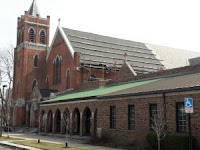The neighboring parish of St. Joseph was established in 1870 less than half a mile away. The cornerstone of the current church was laid on July 26, 1873, though it took a decade to finish. During this time, St. Charles went through a succession of six pastors within the next fifteen years.
Many parishes at the time were divided by ethnicity and language so St. Joseph became home to German-Americans and St. Charles Borromeo Parish, with many Irish-Americans, was renamed to St. Patrick Parish in 1886. Another parish, Our Lady of Mt. Carmel, was established in 1899 and became home to many Polish-Americans.
 |
| Wyandotte in 1896 |
 |
| The interior of St. Patrick Church in the 1910s. |
The high altar, made from white marble, was added in the 1920's.
The church's organ was installed in 1929 and later received two full restorations.
A new convent was built in 1955 at a cost of $225,000 (likely adjusted for inflation). The high school closed in 1968 and was demolished in the 1980's to make room for parish offices and a child care center.
While the parish no longer has parochial schools, it does support Gabriel Richard High School in Riverview and John Paul II Elementary School in Lincoln Park.
Most of the stained-glass in the windows was replaced because the cost of repair was prohibitive. However, the top, triangular portion of each window was salvaged and reused.
More renovations were completed in the early 2000's. Large portions of the flooring were replaced with travertine tile; a local carpenter created a custom celebrant's chair and lectern. A new baptismal font was custom built by a New York firm.
In 2010, St. Patrick was clustered with St. Joseph and St. Elizabeth (est. 1924). Three years later, they merged to form the new parish of St. Vincent Pallotti. The parish is named after of the founder of the Society of Catholic Apostolate, also called Pallottines, which is the community that ministers to the parish. St. Patrick and St. Joseph remained open but St. Elizabeth Church soon closed. At the time of the merger, there were 425 families at St. Patrick and dozen of those families could trace their lineage to beginning of the parish.
St. Patrick Church recently reopened for the Third Sunday of Advent and has resumed the normal schedule.
The Blessed Virgin Mary and St. Elizabeth of Hungary on the left side.
The Sacred Heart of Jesus and St Vincent Pallotti on the right side.
A confessional stands at the edge of the sanctuary, next to a baptismal font and Paschal candle.
St. Patrick Church is built in a Gothic Revival style with many pointed arches. The frames of the Stations of the Cross have Gothic-style spires.
A large crucifix hangs on the west wall, in between the 12th & 13th Stations of the Cross.
Four large saint statues are suspended at the back of the nave: St. Patrick, St. Anthony of Padua, St. Thérèse of Lisieux and St. Joseph.
Symbols of Christ are painted on the ceiling, above the center aisle.
A few of the ceiling frescoes, including St. Gregory and St. Agnes
A small, circular window is in the top of each transept. The window in the west transept has a clover in the middle while the east window shows a fleur-de-lis.
Windows above one of the exterior doors.
A window in the narthex shows a European sailor and a Native American; one of several lightpieces in the narthex.
A hallway between the church and former school houses memorabilia and trophies from the parish schools.
Another set of windows displays the faith and work of the parish, pictured in liturgy, education, etc.
St. Vincent Pallotti Parish has nearly reached its $1.2 million campaign to restore both St. Patrick and St. Joseph Churches.
More about the parish: STVPP.org
More photos by AOD Film Services: St. Patrick
Articles by The News Herald: 155th anniversary + parish cluster
More about the Irish Pallottines: IrishPallottines.org
Articles from The Michigan Catholic: October 2011 + March 2016

















































I graduated from St. Patrick High School in 1961. My High School days were very memorable. I went on to get a B.S. Degree in Industrial Management from Wayne State University, Detroit,Mi and a Masters from the University of Detroit in Industrial Psychology. The basic I received at St. Pat's went a long way toward making that possible.
ReplyDelete